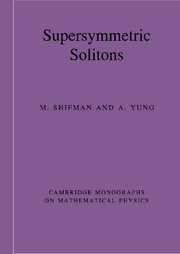Book contents
10 - Conclusions
Published online by Cambridge University Press: 28 July 2009
Summary
This concludes our travel diary in the land of supersymmetric solitons in gauge theories. It is time to summarize the lessons.
Advances in supersymmetric solitons, especially in non-Abelian gauge theories, that have taken place since 1996, are impressive. In the bulk of this book we thoroughly discussed many aspects of the subject at a technical level. Important and relevant technical details presented above should not overshadow the big picture, which has been in the making since 1973. Sometimes people tend to forget about this big picture which is understandable: its development is painfully slow and notoriously difficult.
Let us ask ourselves: what is the most remarkable feature of quantum chromodynamics and QCD-like theories? The fact that at the Lagrangian level one deals with quarks and gluons while experimentalists detect pions, protons, glueballs and other color singlet states – never quarks and gluons – is the single most salient feature of non-Abelian gauge theories at strong coupling. Color confinement makes colored degrees of freedom inseparable. In a bid to understand this phenomenon Nambu, 't Hooft and Mandelstam suggested in the mid 1970s (independently but practically simultaneously) a “non-Abelian dual Meissner effect.” At that time their suggestion was more of a dream than a physical scenario. According to their vision, “non-Abelian monopoles” condense in the vacuum resulting in formation of “non-Abelian chromoelectric flux tubes” between color charges, e.g. between a probe heavy quark and antiquark.
- Type
- Chapter
- Information
- Supersymmetric Solitons , pp. 223 - 227Publisher: Cambridge University PressPrint publication year: 2009



